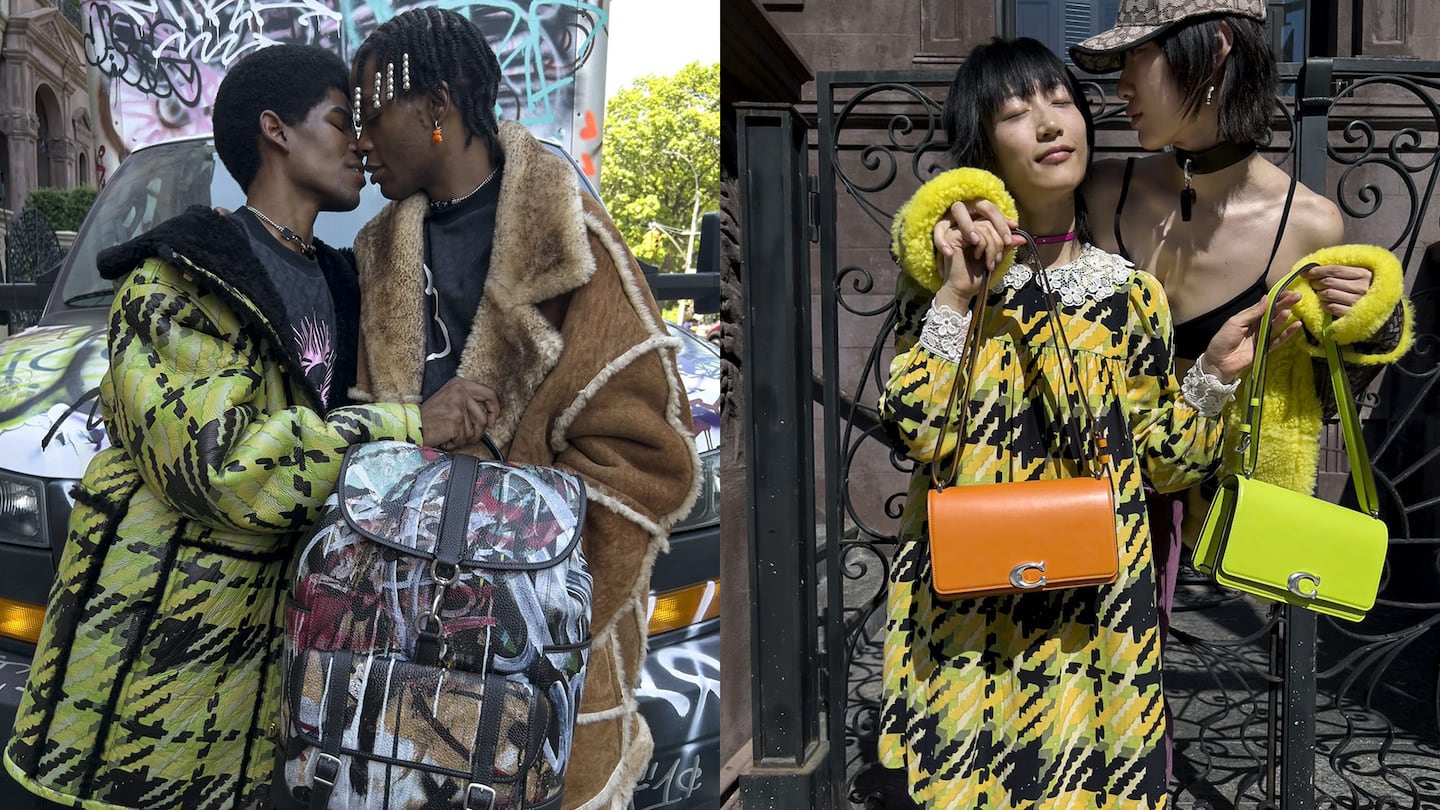
The Business of Fashion
Agenda-setting intelligence, analysis and advice for the global fashion community.

Agenda-setting intelligence, analysis and advice for the global fashion community.

Fashion has come to know many Coaches.
The New York-based leather goods brand has been the shoulder bag for the masses, the wristlet to every American tween, the high-fashion hopeful, the soaring demand and slinking sentiment. But for its next act, Coach will play fashion’s Dr. Frankenstein, and kill the monster it created: accessible luxury, fashion’s midland between ultra cheap and luxury.
“This idea of accessible luxury, or trying to redefine access to luxury did us a disservice,” chief executive Todd Kahn told BoF exclusively. “It put us in a box that we don’t live in anymore.”
At Coach’s investor day Friday, the brand is coining a new term, “expressive luxury,” as part of a broader repositioning meant to lure Gen-Z and lean away from the down market connotations of “accessible,” and more into “luxury.”
ADVERTISEMENT
The repositioning builds on the turnaround Coach began a decade ago after falling into a discounting dash with accessible luxury joiners like Michael Kors. To change its luck back then, the label tasked ex-Loewe, ex-Louis Vuitton import Stuart Vevers with making the case for Coach as a lifestyle brand with a high-fashion temperament. He launched ready-to-wear, and concepts like Rexy the dinosaur, but nothing seemed to stick. Sales stayed stagnant and executives went through a revolving door.
Coach started to see some momentum internationally in 2019, but North American sales continued to deteriorate. The pandemic erased any progress and then some. By mid 2020, when Todd Kahn — a 14-year veteran of the brand — was appointed interim CEO of the brand, shares in Tapestry, Coach’s parent company, were trading at their lowest point since the 2009 financial crisis. Coach itself was in need of a lifeline.
“I felt a little bit like Winston Churchill on the eve of World War II,” said Kahn.
It seems Coach’s efforts are starting to pay off. In its most recent fiscal year the brand’s overall sales recovered to above pre-pandemic levels, up 16 percent year-over-year to $4.9 billion. It managed to raise the average price of its handbags by 30 percent compared to 2019. A BoF Insights report found Coach was the first brand most US shoppers thought of when considering buying a bag, and it ranked in the top 10 among high-net-worth individuals in the US and China. Coach recruited nearly 8 million new customers in North America in the last two years.
Coach was one of the first among mid-luxury American brands to acknowledge it had been devalued, with Michael Kors and Ralph Lauren now targeting the same sort of brand elevation, said BMO Capital Markets managing director and senior analyst Simeon Siegal. They are all racing to cement their high-end status, which will help them weather a recession that is likely to hit lower-income customers harder than wealthy ones.
“The hardest question in fashion is figuring out the right balance between exclusivity and distribution,” said Siegel. “It’s figuring out how to sell a lot without losing the ability to command price.”
Starting in the early 2010s, Coach set out to claw back pricing power. It cut costs, reduced inventory, and pulled back on department stores, building a fleet of outlets, where it could push out cheaper bags for a mass consumer without relying on extreme discounting. Sales inched up incrementally, but unremarkably.
During the pandemic, Coach debuted a plan to beef up data and digital. It established an e-commerce arm, boosting online sales from 8 percent of total revenue in 2020 to about 30 percent now, said Kahn. It started to look at its customer clearly, rather than aspirationally. Kahn acknowledged as much on an earnings call in 2020: “At certain times we have placed too much focus on the customer we wanted and not on who our customer actually is.”
ADVERTISEMENT
The target customer shops across channels, purchasing a $200 bag one day, then an $800 bag the next, Kahn said. Rather than offering full-price items on Fifth Avenue and discounts hidden in the suburbs, they commingle online — to a point. Customers could buy basic products on coachoutlet.com for under $500, and embellished, limited edition versions on Coach.com for more.
Coach also started to get release cadence and product right. Noticing the popularity of its Tabby bag in 2019, it put out a puffy update in 2021, rather than phasing it to outlets and focusing on a new shape. Coach has since updated the Tabby with a soft version and different colourways at a range of price points — from $195 up to $4,500.
It’s done the same with other popular bags. This month the brand put out a graffiti-covered Rogue as part of a collaboration with artists Mint + Serf. Last month, it turned the silhouette to a cartoon, with leather eyes and shearling eyebrows to make “Coachies.”
“It’s actually a much stronger formula for success than constantly bringing newness and prematurely killing off fabulous bags,” said Kahn.
In a statement ahead of its investor call, Tapestry said it expects Coach revenue to grow to $5.7 billion by 2025.
The brand has had some help from its rivals in finding a bigger audience for its full price merchandise. According to Jefferies, luxury brands increased prices by 10.7 percent on average in 2021, and have already bumped prices 10.3 percent this year. The price of certain Chanel bags has doubled since 2019. Coach’s bags, still mostly under $1,000, appeal to priced-out entry-level luxury consumers.
“The white space between us and them has grown more than at any time in our history,” said Kahn.
The rise of resale could make things more difficult, said Michael Binetti, managing director and senior equity analyst at Credit Suisse. What’s stopping a consumer from buying a secondhand Gucci bag for $1000, rather than a new Coach bag for the same price?
ADVERTISEMENT
Where Coach has gone for a more streamlined approach to merchandising, it’s adopted the opposite strategy when it comes to ambassadors — an attempt to get people to think of Coach as more than a price tag, and create a virtuous halo around product. Since tapping Selena Gomez in 2016, Coach now counts over 40 global influencers, musicians, actors and other celebrities on its roster.
They are often photographed by the fashion-forward Juergen Teller, or appear in goofy campaigns like Coach’s Season 2, where Megan Thee Stallion, Jennifer Lopez and K-Pop’s Dawn channelled nostalgia in TV ads and pop-culture moments alongside more niche names like Tavi Gevinson and Hari Nef.
A wide array of ambassadors is key to widening Coach’s audience, said Kahn. The brand will tap fresh spokespeople, but its marketing will focus more on telling stories and pushing Coach as the key to expressing personal style.
“Much like in 2000 when Coach coined the term accessible luxury and entered a golden age, this is the next golden age for Coach with expressive luxury,” said Kahn.
To keep growing, Coach will have to figure out a way to sell more products to more customers, while retaining control of brand perception, said Siegel.
The brand has caught up in terms of digital, with a growing e-commerce platform and fun, influencer-thronged social media presence — even finding success on TikTok, helped by the 7,500 influencers with over 10,000 followers that have posted about Coach at least once this year, according to data firm Tribe Dynamics. Key creators like Alyssa McKay promoted the label’s outlet offering: #CoachOutlet generated almost $4.9 million in earned media value, said Tribe Dynamics.
Elsewhere, Coach continues to bolster its image with celebrities, recently unveiling custom looks for Lil Nas X, and campaigns with the Haim sisters, Megan Thee Stallion and Japanese actor Dean Fujioka. Whether it has managed to convince shoppers it’s worth a rising regular price remains up in the air.
Added to that, the world is in the midst of a Covid hangover, said Siegel. Doing business in China, which is a significant driver for Coach, is getting even more difficult. During the pandemic, demand for handbags shot up, but hasn’t yet regulated, said Siegel. That could make it difficult for Coach to get supply right, and avoid falling into the death toll of discounting.
“I don’t know that we know what the new normal is yet … the question is going to be who can maintain their brand elevation at the price points,” said Siegel.
Coach thinks by re-writing the accessibility narrative that plagued it, and shifting to fit what it sees as Gen-Z’s evolving conception of luxury, it can create staying power. A promising sign: Coach overtook both Michael Kors and Louis Vuitton as teens’ favourite handbag brand in Piper Sandler’s Spring 2022 survey.
“We excavated our purpose — and I use the word excavate very intentionally because it was always there,” said Kahn.
 Opens in new window
Opens in new windowAccessible luxury brands like Coach and Michael Kors radically changed their approach to everything from logos to discounting to regain their old cachet with consumers. It’s working, but for how long?
The 80-year-old heritage leather goods maker has spent much of the last year leaning into a marketing strategy that emphasised fun. Its efforts are paying off.

Joan Kennedy is Editorial Associate at The Business of Fashion. She is based in New York and covers beauty and marketing.
The fashion giant has been working with advisers to study possibilities for the Marc Jacobs brand after being approached by suitors.
A runway show at corporate headquarters underscored how the brand’s nearly decade-long quest to elevate its image — and prices — is finally paying off.
Mining company Anglo American is considering offloading its storied diamond unit. It won’t be an easy sell.
The deal is expected to help tip the company into profit for the first time and has got some speculating whether Beckham may one day eclipse her husband in money-making potential.